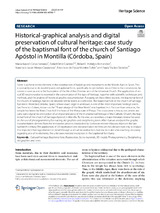Mostrar el registro sencillo del ítem
Historical-graphical analysis and digital preservation of cultural heritage: case study of the baptismal font of the church of Santiago Apóstol in Montilla (Córdoba, Spain)
| dc.contributor.author | Calvo-Serrano, M. Araceli | |
| dc.contributor.author | Ortiz Cordero, Rafael | |
| dc.contributor.author | Hidalgo Fernández, Rafael E. | |
| dc.contributor.author | Mesas Carrascosa, Francisco Javier | |
| dc.contributor.author | Montes Tubío, Francisco de Paula | |
| dc.contributor.author | Triviño Tarradas, Paula María | |
| dc.date.accessioned | 2024-02-06T14:24:13Z | |
| dc.date.available | 2024-02-06T14:24:13Z | |
| dc.date.issued | 2022 | |
| dc.identifier.uri | http://hdl.handle.net/10396/27174 | |
| dc.description.abstract | Stone is a characteristic element in the construction of buildings and monuments in the Middle Ages in Spain. This is so mainly due to its durability and, in baptismal fonts, specifically, its symbolism: Jesus Christ is the cornerstone, he comes to save us and is the foundation of the life of the Christian and of the Universal Church. The application of virtual 3D reconstruction is essential in the conservation of this type of heritage, together with scientific techniques and methods, and the analysis of historical-graphic documentation. Focusing on these three aspects, the baptismal font of the church of Santiago Apóstol de Montilla will be taken as a reference. The baptismal font of the church of Santiago Apóstol in Montilla (Córdoba, Spain), whose exact origin is unknown, is one of the most important heritage assets. San Francisco Solano, known as the “Thaumaturge of the New World”, was baptised in it. For over four centuries, the temple has been the Main Church of the head of the Marquisate of Priego. This study aims to know, document and carry out a digital reconstruction of an important piece of the monumental heritage of the Catholic Church: the baptismal font of the church of Santiago Apóstol in Montilla. To this end, we searched a major literature review focused on the use of photogrammetry for reading old graphics and deciphering texts. After that we analysed the graphic documentation derived from the restoration process conducted by Cordovan restorer Vázquez Arjona in the late twentieth century. The application of 3D digitisation and documentation techniques has allowed not only to analyse this important heritage element in detail through a virtual reconstruction, but also to make a far-reaching discovery regarding one of its elements, the unknown inserted inscription in the baptismal font band. | es_ES |
| dc.format.mimetype | application/pdf | es_ES |
| dc.language.iso | eng | es_ES |
| dc.publisher | Springer | es_ES |
| dc.rights | https://creativecommons.org/licenses/by/4.0/ | es_ES |
| dc.source | Calvo-Serrano, M.A., Ortiz-Cordero, R., Hidalgo-Fernandez, R.E. et al. Historical-graphical analysis and digital preservation of cultural heritage: case study of the baptismal font of the church of Santiago Apóstol in Montilla (Córdoba, Spain). Herit Sci 10, 149 (2022). https://doi.org/10.1186/s40494-022-00782-7 | es_ES |
| dc.subject | Cultural heritage | es_ES |
| dc.subject | Baptismal font | es_ES |
| dc.subject | Restoration | es_ES |
| dc.subject | Stone materials | es_ES |
| dc.subject | 3D model | es_ES |
| dc.subject | Photogrammetry | es_ES |
| dc.subject | Deciphering old graphics and texts | es_ES |
| dc.title | Historical-graphical analysis and digital preservation of cultural heritage: case study of the baptismal font of the church of Santiago Apóstol in Montilla (Córdoba, Spain) | es_ES |
| dc.type | info:eu-repo/semantics/article | es_ES |
| dc.relation.publisherversion | https://doi.org/10.1186/s40494-022-00782-7 | es_ES |
| dc.rights.accessRights | info:eu-repo/semantics/openAccess | es_ES |

